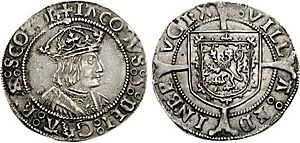Renaissance in Scotland facts for kids
The Renaissance in Scotland was a big change in culture, ideas, and art. It happened from the late 1400s to the early 1600s. This period was part of a larger European movement called the Renaissance, which started in Italy in the late 1300s. The Renaissance aimed to bring back ideas from ancient Greece and Rome. These ideas included humanism (focusing on human values), asking questions, being a bit skeptical, and valuing balance and good design.
Historians used to think the Renaissance was one big, clear change. But now, they see it as many important shifts. In Scotland, these changes greatly affected education, thinking, writing, art, buildings, music, science, and even how the country was ruled.
The king's court was very important. It helped artists and thinkers, and it was where grand events showed off the monarchy's power. The Renaissance also brought new ideas about kingship. Scottish kings started to see themselves as powerful rulers, like emperors. Education became more important, leading to more schools and six university colleges by the end of the 1500s. Many Scottish scholars studied abroad and then returned to share their new knowledge.
Scottish writers started using their own language, Scots, more often. But Latin was still important for writing. Kings like James V and James VI supported many writers.
In the 1500s, Scottish kings built palaces in the Renaissance style, starting with Linlithgow Palace. This trend soon spread to rich families. Painting was much influenced by artists from Flanders (modern-day Belgium and Netherlands). While church art changed due to the Scottish Reformation, house decorations and portraits became popular for wealthy people. George Jamesone became Scotland's first famous painter in the early 1600s.
Music also took on European styles. However, the Reformation meant less complex church music and more simple singing of psalms. After the Union of Crowns in 1603, when Scotland and England shared a king, the church and court stopped supporting artists as much. This changed how art was made. By the early 1600s, new styles like Mannerism and Baroque began to replace the Renaissance.
Contents
What Was the Renaissance?
The word "Renaissance" means "rebirth." It was first used by a historian in the mid-1800s to describe a time when people in Italy started looking back at the ideas and art of ancient Greece and Rome. This movement encouraged thinking, questioning, and valuing balance and beauty in art. These ideas reached Northern Europe, including Scotland, later in the 1400s. The Northern Renaissance lasted until the early 1600s, when it was replaced by the grander Baroque style.
Some historians used to think Scotland wasn't really part of the Renaissance. But now, we know that many important changes happened in Scotland during this time. These changes helped prepare Scotland for the Reformation and later for the Enlightenment, a period of great new ideas.
Kings and Their Courts
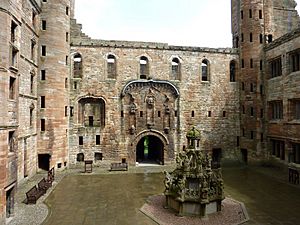
The king's court was the heart of Renaissance ideas and art. It was also where kings showed off their power and importance. This often involved fancy events that mixed old ideas of chivalry (knightly behavior) with new Renaissance styles. Knights like Hector of Troy, Alexander the Great, and Julius Caesar were seen as early examples of chivalry.
Tournaments were a popular way to show off. King James IV held famous tournaments like the Wild Knight in 1507. King James V also loved tournaments and showed off his knightly awards at Linlithgow Palace.
When Mary, Queen of Scots returned from France in 1561, she brought many fancy court events with her. She held balls, plays, and parties to show the monarchy's strength and unite the country. A very grand event was the baptism of her son, James VI, at Stirling Castle in 1566. It combined old Greek myths with knightly themes. The celebration included a feast, hunts, poetry, dancing, and even fireworks!
King James VI also made his court a center for culture and learning. He wanted to be seen as a "philosopher king." The biggest event of his reign was the baptism of his son, Prince Henry, in 1595. For this, the Chapel Royal at Stirling Castle was rebuilt to look like the Temple of Solomon. There were three days of feasting, a staged tournament, and a play with a "ship of state" full of gods and muses. This event was designed to make the king look powerful and support his claim to the English throne.
New ideas also changed how people viewed kings. Kings were seen as more important and powerful. From the mid-1400s, Scottish Parliament declared that King James III had "full power and empire within his realm." From the 1480s, the king's image on his silver coins showed him wearing a closed, arched crown, like an emperor's. This was one of the first times such a crown appeared on coins outside Italy. It soon appeared in other places, like on royal seals and church steeples. King James V was the first Scottish king to wear such a crown in real life. These ideas made the crown seem more dignified and important, uniting the country and showing the king's power over law and the church.
Kings also started relying on "new men" (people who weren't powerful nobles) and using church leaders as government workers. They also developed standing armies and a navy. King James VI took these ideas even further, believing that kings ruled by "divine right" (chosen by God).
Learning and Schools
Schools in the Renaissance
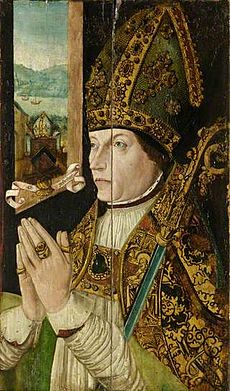
In the early Middle Ages, formal education was mostly for monks. But from the 1100s, new schools like song schools and grammar schools began to appear. These were usually connected to churches and were common in growing towns. By the end of the Middle Ages, grammar schools were in all main towns. There were also smaller "petty schools" in rural areas for basic education. Most schools were for boys, but by the late 1400s, Edinburgh also had schools for girls, often called "sewing schools." Wealthy families also hired private tutors.
The focus on education grew, leading to the Education Act 1496. This law said that all sons of important landowners should go to grammar schools to learn "perfect Latin." This helped more people become literate, especially wealthy men. About 60% of nobles could read by the late 1400s.
After the Reformation, Protestant reformers also wanted more education. They wanted people to be "godly" (religious). In 1560, the First Book of Discipline suggested a school in every parish, but this was too expensive. In towns, old schools continued, becoming reformed grammar schools or parish schools. Schools were supported by church funds, local landowners, and parents who could pay. Church groups checked the teaching quality and religious beliefs.
There were also many "adventure schools" that were not regulated. These sometimes helped local needs or took students from official schools. Outside the main town schools, teachers often had other jobs, like working for the church. The best schools taught religious lessons, Latin, French, classic literature, and sports. It took until the late 1600s to have a good network of parish schools in the Lowlands. In the Highlands, basic education was still missing in many areas even by 1696.
Universities in the Renaissance
The 1100s saw important thinkers emerge from Scotland, like John Duns Scotus (around 1265–1308). After the Wars of Scottish Independence began in 1296, English universities were mostly closed to Scots. So, Scottish students went to universities in Europe. Over a thousand Scots studied in Europe between the 1100s and 1410. Some, like Walter Wardlaw and Laurence de Lindores, even became teachers there.
This changed with the founding of Scottish universities: University of St Andrews in 1413, University of Glasgow in 1450, and University of Aberdeen in 1495. At first, these universities trained church leaders. But more and more, they were used by ordinary people who wanted jobs in government and law. In this period, Scottish universities did not teach Greek. They focused on philosophy and mostly followed the ideas of Aristotle. Students who wanted advanced degrees still had to go abroad.

By 1495, some Scots were in touch with Desiderius Erasmus, a leading humanist thinker from the Netherlands. They also knew Jacques Lefèvre d'Étaples, a French scholar. These connections helped bring new humanist ideas to Scotland. In 1497, Hector Boece, a humanist historian who studied in Paris, returned to be the first principal of the new University of Aberdeen.
After the Reformation, Scottish universities were reformed by Andrew Melville. He returned from Geneva in 1574 to lead the University of Glasgow. Melville changed how things were taught, making logic simpler and allowing students to question old ideas. He brought in new specialized teachers. Greek became a required subject in the first year, followed by other ancient languages like Hebrew. Glasgow, which had been struggling, saw many more students attend. Melville also helped rebuild Marischal College in Aberdeen and became principal of St Mary's College, St Andrews in 1580. These changes made Scottish universities as good as any in Europe.
An important thinker during the Reformation was George Buchanan. He taught in France and Portugal and translated Greek texts into Latin. He also tutored Mary, Queen of Scots and later her son, James VI. Buchanan wrote books that argued for limiting the power of kings. While he helped make James VI a very educated Protestant prince, he couldn't convince the king to agree with his ideas about limited monarchy.
Writing and Literature
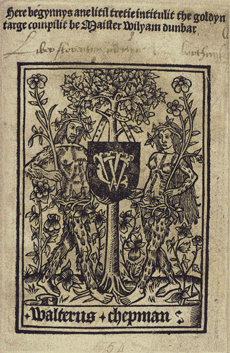
In the late 1400s, Scottish prose (writing that isn't poetry) also began to develop. The first complete surviving work is John Ireland's The Meroure of Wyssdome (1490). There were also Scots translations of French chivalry books.
The first printing press in Scotland was set up in 1507 by King James IV. This made it easier to share Scottish literature. A major work from James IV's reign was Gavin Douglas's translation of Virgil's Aeneid, called the Eneados. It was the first full translation of a major classical text into an English-like language.
Many Scottish writers, called "makars," were poets connected to the royal court. These included James I, who wrote The Kingis Quair. Many makars also went to university and were connected to the church. Before printing became common, poets like William Dunbar, Gavin Douglas, Robert Henryson, and Walter Kennedy were seen as leading a "golden age" of Scottish poetry. They continued medieval themes but were also influenced by new European trends and Renaissance styles.
King James V supported poets like William Stewart and John Bellenden. Stewart wrote a poem version of a Latin history of Scotland. Bellenden translated a Roman history book into prose. Sir David Lindsay, a diplomat and head of the Lyon Court, was a very productive poet. He wrote A Satire of the Three Estates in 1540, which was the first full Scottish play that still exists. It made fun of corruption in the church and government, using medieval play styles with a humanist message.
In the 1580s and 1590s, King James VI promoted Scottish literature. His book, Some Rules and Cautions to be Observed and Eschewed in Scottish Prosody (1584), was a guide to poetry and described the Scottish poetic tradition. He applied Renaissance ideas to it. He became a patron and member of a group of Scottish court poets and musicians called the Castalian Band, which included William Fowler and Alexander Montgomerie.
By the late 1590s, James's focus on Scottish traditions lessened as he hoped to become King of England. Some poets who followed him to London after 1603 started to use more English words in their writing. James's role as a writer and patron in Scotland made him important for English Renaissance poetry and drama, but his support for Scottish writing became less important.
Buildings and Architecture
The Renaissance influenced Scottish architecture in two main ways. First, in the early 1400s, churches started using some Romanesque (old Roman-like) shapes. This might have been because of close ties with Rome and the Netherlands, and perhaps a way to be different from English Gothic styles. You can see this in Dunkeld Cathedral (started 1406) and St Mary's Collegiate Church, Haddington (1460s). About forty collegiate churches were built in Scotland in the late 1400s and early 1500s. Many, like Trinity College, Edinburgh, mixed Gothic and Renaissance styles.

Kings started building and rebuilding many royal palaces, especially under James III, James IV, and James V. These buildings clearly show Renaissance styles. Linlithgow Palace was first built under James I. By 1429, it was called a "palace," which was new for Scotland. It was expanded under James III to look like a fashionable Italian palace, mixing classical balance with knightly images. Italian builders worked for James IV, who finished Linlithgow.
James V saw French Renaissance buildings when he visited France for his marriages. His second marriage to Mary of Guise may have brought more French influences. His buildings often ignored the English Tudor style and adopted clear European forms. This started with work at Linlithgow, then Holyrood Palace, Falkland Palace, Stirling Castle, and Edinburgh Castle. These are called "some of the finest examples of Renaissance architecture in Britain." Scottish buildings didn't just copy European styles. They mixed them with traditional Scottish designs and materials, especially stone.
Work for King James VI also showed Renaissance influences. The Chapel Royal at Stirling had a classical entrance built in 1594. The North Wing of Linlithgow, built in 1618, used classical pediments (triangular shapes above doors or windows). Rich families also built houses with similar themes, like Mar's Wark in Stirling (around 1570).
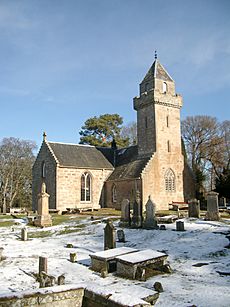
New military architecture, like the "trace italienne" (Italian style fort), was brought by Italian architects during the war of the Rough Wooing and Mary of Guise's rule. This included Migliorino Ubaldini at Edinburgh Castle.
A unique style of large private houses in Scotland, later called Scots baronial, started around the 1560s. It kept many features of old castles, even though gunpowder weapons made them less useful. It might have been influenced by French builders who worked on royal palaces. It used ideas from tower houses and peel towers, which local lords had built for centuries. These buildings were designed to survive a raid, not a long siege. They usually had three stories with a parapet (a low wall) and round towers at the corners. New houses kept these outer features but were larger, often in a "Z-plan" shape, like Colliston Castle (1583).
William Wallace, the king's master builder from 1617 to 1631, was very important. He worked on rebuilding Linlithgow and Heriot's Hospital in Edinburgh. He created a special style that mixed Scottish fort features and Flemish influences with a Renaissance plan. This style was very popular for lords' houses until the late 1600s.
After 1560, the Reformation completely changed church architecture in Scotland. Protestants did not want fancy decorations in churches. This led to the destruction of many medieval church items like stained glass and sculptures. Churches needed to be adapted or built new for reformed services, with more focus on preaching. Many early churches were simple rectangles, a style that continued into the 1600s, like at Dunnottar Castle (1580s). Greyfriars Kirk in Edinburgh (1602–1620) used this layout with a Gothic style. A common design was the "T"-shaped plan, which allowed many people to be near the pulpit. Examples include Kemback (1582) and Prestonpans (after 1595). In the 1600s, some churches used a Greek cross plan, like Cawdor (1619).
Art and Painting
We don't know much about Scottish artists from the Middle Ages. Royal portraits from that time were often not as good as those from Europe. But works by artists brought from Europe, especially the Netherlands, were much better. These included a portrait of William Elphinstone and an altarpiece for Trinity College Kirk in Edinburgh.
Many beautiful prayer books from the late 1400s and early 1500s were made in the Netherlands and France for Scottish patrons. One example is the Hours of James IV of Scotland, given by King James IV to Margaret Tudor. It's considered one of the finest medieval manuscripts made for Scotland.
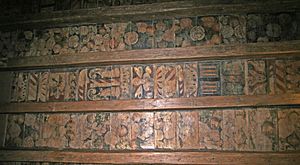
Surviving stone carvings, wall paintings, and royal tapestries show how rich royal art was in the 1500s. At Stirling Castle, stone carvings on the royal palace used German designs. The carved oak portraits from the King's Presence Chamber, known as the Stirling Heads, include figures from history, the Bible, and classical myths. Some wood carvings were made by French artists who settled in Scotland.
The Reformation caused great damage to church art in Scotland. Almost all medieval stained glass, religious sculptures, and paintings were lost. This meant artists had to find new patrons. As a result, Scottish Renaissance painted ceilings and walls became popular. Many private houses of wealthy people got detailed and colorful patterns and scenes. Over a hundred examples are known. These were done by Scottish artists using European pattern books, often including symbols from humanism, religion, classical myths, and allegories.
In 1502, King Henry VII sent his Flemish portrait painter Maynard Wewyck to the Scottish court. Later in the 1500s, unknown artists painted portraits of important people. The tradition of royal portrait painting in Scotland was often interrupted by periods when kings were too young to rule. King James VI hired two Flemish artists, Arnold Bronckorst and Adrian Vanson, who painted the king and important court figures. The first important Scottish artist was George Jamesone (1589/90–1644) from Aberdeen. He became a very successful portrait painter and trained the Baroque artist John Michael Wright.
Music in the Renaissance
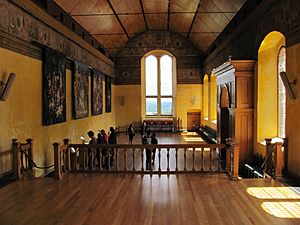
When King James I was held captive in England (1406–1423), he became known as a poet and composer. He may have brought English and European music styles and musicians back to Scotland when he was freed. In the late 1400s, several Scottish musicians trained in the Netherlands, which was a major music center in Europe. They then returned home.
In 1501, King James IV rebuilt the Chapel Royal at Stirling Castle, making its choir larger. This became the main place for church music in Scotland. English and Burgundian (French) influences likely grew when King Henry VII's daughter, Margaret Tudor, married James IV in 1503. The most important Scottish composer of the early 1500s was Robert Carver (around 1488–1558). Five of his masses and two anthems have survived. His complex music could only be performed by a large, well-trained choir like the one at the Chapel Royal. King James V also supported musicians like David Peebles.
In this time, Scotland followed the European trend of using instruments with singing. Records show that lutenists (people who play the lute) were at the court from James III's reign. Instruments also appear in art, like a ceiling at Crathes Castle showing muses with lutes, viols, fiddles, harps, and flutes. Playing music became an important skill for Renaissance courtiers and even royalty. James IV played the "clarychords and lute" for his bride, Margaret Tudor. James V was a talented lute player and brought French songs and groups of viols to his court.
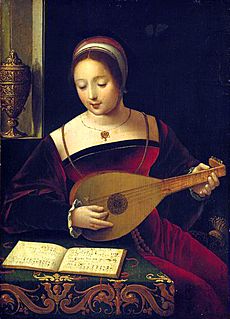
The Reformation greatly affected church music. Song schools in churches were closed, choirs were disbanded, music books were destroyed, and organs were removed from churches. The early Scottish Reformation, influenced by Lutheranism, tried to keep some Catholic music traditions. The most important example was The Gude and Godlie Ballatis, which were religious versions of popular songs.
Later, Calvinism, which became dominant in Scotland, was much stricter. It focused only on biblical songs, mainly the Psalms. The Scottish psalter of 1564 was created for the church. It used work from French and English writers. The goal was to have a unique tune for each psalm. Most church music became simpler, with everyone singing the melody.
When King James V's daughter, Mary, returned from France in 1561, her Catholic faith gave new life to the Scottish Chapel Royal choir. But since church organs were destroyed, musicians used trumpets, drums, flutes, bagpipes, and tabors to accompany the mass. Like her father, Mary played the lute and virginals, and she was a good singer. She brought French musical influences, hiring lutenists and viol players.
King James VI was a big supporter of the arts. He tried to bring back town song schools from 1579. He rebuilt the Chapel Royal at Stirling in 1594, and its choir was used for important events like his son Henry's baptism. He also hired lutenists for his own entertainment. When he moved to England in 1603 to become King of England, he took away a major source of art support in Scotland. The Scottish Chapel Royal fell into disrepair, and the court in Westminster became the only main source of royal music support.
What Came Next
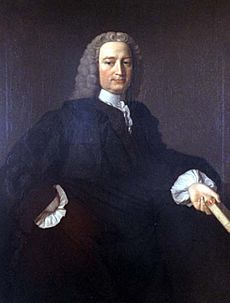
The Renaissance in Scotland was at its strongest in the first half of the 1500s. The church stopped supporting artists in the 1560s, and the royal court moved to England in 1603. These changes limited how Renaissance ideas could grow further. In art and architecture, the balanced Renaissance style started to change into Mannerism and the more dramatic Baroque style around 1620.
The Renaissance left a lasting impact on Scotland. It helped change the ruling class from warriors to people with more refined values. Humanism made learning seem very important, which helped create Scotland's strong school and university systems. The Education Act 1496 set a standard for public education, which reformers continued and expanded later. The creation of Scottish universities, especially with the reforms by Melville, allowed Scotland to be part of Europe's "educational revolution." This was crucial for the Scottish Enlightenment, a period of great new ideas in Scotland.
The Renaissance also left its mark on poetry, history writing, and architecture, continuing into the 1600s and 1700s. More Scottish scholars became confident in their own literature. One reason for the sudden burst of the Scottish Enlightenment was that Scotland already had a history of achievements in philosophy, poetry, music, math, and architecture. It was also closely connected to new ideas across Europe. From this period, Scotland made major contributions in medicine, law, philosophy, geology, and history. The idea of limiting a king's power also remained important in Scottish thought and played a role in later debates.
See also
- Renaissance architecture in Scotland
- Early Renaissance
- Late Renaissance
External links|


